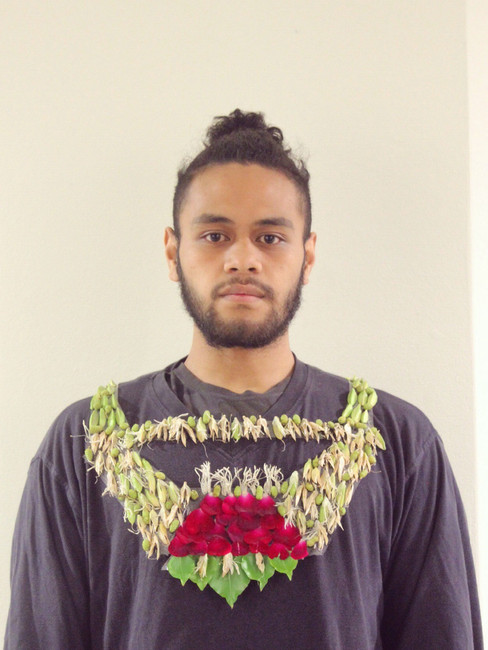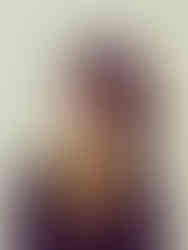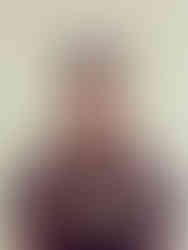Sione Tuívailala Monū has a grid and they know how to use it. They chat to Fairooz Samy about their new exhibit, and the power of Instagram.

For the Instagram generation, SioneTuívailala Monū is the moment. The New Zealand-born, Australian-raised artist is effervescent and unbothered. Their work is about self-expression without the need for justification, as demonstrated by their whimsical IG bio, in which Sione describes themselves as ‘emerging-early-career-slut-artist’, an ‘iconic squirrel’, and ‘45 years old’ (though they’re 30, with the exuberance and skin texture of a 24-year-old).

Sione was creative from a young age and their imagination was nurtured by their parents. “My mum and dad were a big part of my creative life growing up, they would buy me materials for whatever new hobbies I would develop,” they say. “I was always doing something, painting or drawing or making jewellery.” Sione moved back to Aotearoa in 2014, mainly to meet the many queer and Pasifika artists they’d made friends with online. “That was a huge deal for me, in my life in general, not just my art practice,” they explain. “When I got here, I was surrounded by other Pasifika artists and we would make and hang out together, and that’s all I’ve really known.”


Although they’re part of a new generation of multimedia Pasifika creators, Sione pays tribute to established artists for paving their way. “They’ve done the hard yards to get us recognised in these spaces, so I’d say I’m lucky that it feels quite easy to move in the art sphere now, as a Pasifika and queer artist.” There’s a pause, and Sione says with conviction, “I feel, more than anything, a freedom to experiment and play on traditional art forms.”
Instagram has been a constant for Sione. Their video practice began in high school, when Sione would edit vignettes of their life to post on the app, inspired by a love of foreign films and arthouse cinema. “At the time, it wasn’t something I called ‘my video practice’,” they explain, “it wasn’t until I moved here that the art world, curators, etc, would find my Instagram work and place it in a gallery context.” The latest example of this transition from small screen to big space is Sione’s exhibition Stories, which is currently showing at City Gallery Wellington. The walls, painted a millennial pink, create a cosiness that’s amplified by gorgeous hand-made ‘ao kakala (flower clouds) that hang from the ceiling. These ‘ao kakala are an extension of nimamea'a tuikakala, the craft of Tongan embroidery and crochet. The adornments characterise Sione, in that nimamea'a tuikakala is a recurring aspect of Sione’s art and their vibrance reflects that of the artist who made them.

Projected onto the walls are videos shot for Sione’s IG, chronicling the highs and lows of their diasporic experience in Tāmaki Makaurau, Melbourne, Sydney, and Canberra. “The Stories exhibition feels like it’s all led to an accumulation of my work, from the beginning to now, regarding my video making and the world-building that I’ve done through that platform.” Sione admits they were initially nervous. “I was worried about what people would think, and that they might not take it seriously, but it turned out really beautiful and very fun.” Despite its subtle commentary on creating purpose amidst transience, visitors are left with the sense that they’ve wandered into a best friends’ sleepover. The stories are eclectic, ordinary, and funny, showcasing Sione’s charm and their cast of entertaining friends and whānau. “At the opening, I saw people giggling and laughing which made me really happy,” smiles Sione, “and I think I’m going to develop more on that kind of medium, of projection of the stories onto a large wall.”


The vibe, as the kids would say, carries over into Wheke Fortress, an experimental gallery for Māori, Pasifika, and LGBTQIA+ artists in Tāmaki Makaurau. Established by two of Sione’s closest friends, Tokerau Brown (Toki) and Jessicoco Hansell (Coco), Wheke Fortress is a radical and necessary community space that allows marginalised artists “to feel not so ‘out of context’,” explains Sione, “which is how we feel sometimes in the industry.” By virtue of being there throughout the crowd-funding and realisation process, Sione became an unofficial team member, and promotes the space to their Instagram followers.
There is a music studio upstairs, where they and Toki have been doing a lot of animation projects “nine to five at the moment,” and Coco does producing and writing for the animation. There’s also a studio and a boardroom where Coco has writing tables. Wheke Fortress has an atmosphere of self-expression and collegiality, of new-wave artists collaborating purely for fun, often without a goal or agenda. “We invite our friends to the space just to hang out, and usually from that, things like projects come out. It’s a very dreamy space, I feel.”

There’s a parallel between Sione’s relatability and the intimacy of their video work, the public nature of a gallery exhibit ensuring their visibility as an artist. This contrast, of glamour and the everyday, was explored in Leiti, a 2022 moving image work displayed at Auckland Art Gallery Toi o Tāmaki. It’s a visual diary of sorts that pays homage to friendship, sisterhood, resilience, and leitis, the third gender. Leiti features affecting moments depicting Sione and their friend and collaborator, Manuha’apai, living their lives joyously, fabulously, and importantly, mundanely. Their capturing of the mundane and glamorous aspects of their existence reflects the fact that they “felt really tired of the warrior, ‘fighter’ narrative that we are prescribed”, explains Sione. “Yes, we are fighting to survive and all of that, but we wanted to capture that, like everyone else, we’re quite normal.” Sione manages to capture the fullness of their leiti experience, without evoking weariness. “For that exhibition, we wanted to present ourselves as regular humans, living our lives, very softly. That’s something we want to talk about a lot, living softer lives, speaking that into existence, and making work about it was very important to us.”

Sione will expand on the nuances of the leitī third-gender expression in an upcoming exhibit at the Robert Heald Gallery in Wellington, in August. “It’ll be an experimental video work exploring multidimensional leitīs having a kata and a kii”, explains Sione. Heald recently began representing Sione and was impressed by their vivaciousness.
Sione’s videos have an infectious energy and grace. They’re playful, fun, and often irreverent,” says Heald. “When seen together, what emerges is a constant trying-on of selves and almost diaristic obsession with the recording and stilling of time, with a poetic transformation of daily life”, he continues. “This is all achieved with the most basic of modern devices – the cell phone.”
Sione Tuívailala Monū, Canberra family portraits, 2015

In between pioneering short-form video practice and “dragging friends to the cinema”, Sione walks around Auckland’s many mountains, often ending up at an Instagram-worthy food place. When asked what their wildest artistic dream would be, an idea bolts out of Sione’s imagination. “I’d love a huge set-piece with a stadium full of people, all wearing floral, beaded adornments that I’ve made, maybe doing a performance”. Go off, queen.
First published in Art Zone #95







